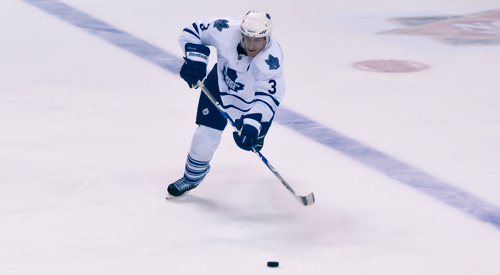
The death of the trolley tracks
The Trolley Tracks, the Bermuda Triangle of the National Hockey League: a place in the neutral zone where few dare skate, for the open ice is fraught with danger.
Players are taught from the earliest age to keep their heads up, especially when venturing into this no-man’s land simply defined as the passageway spanning the length of the neutral zone on either side of the center face-off dot.
The cautionary tales of those who have refused to heed these warnings are filled with broken superstars like Eric Lindros and Paul Kariya, players whose careers were shortened prematurely by violent hits in dangerous territory.
Hell, a key reason why current Toronto Maple Leafs captain Dion Phaneuf was considered a blue chip hockey prospect in the first place was because he had already mastered the Trolley Tracks route at the junior level.
Although they have been a part of the NHL since its inception, the Trolley Tracks and all that they represent may soon go the way of the dodo bird.
The reason extinction looms for the treacherous Tracks is simple: Rule 48.
The NHL’s Rule 48 states that a “hit to an opponent where the head is targeted and/or the principal point of contact is not permitted.” This broadened the rule to include all head shots and not just, as it had been previously, those from blindside or lateral hits.
[php snippet=1]
The new rule has already produced four suspensions totalling 10 preseason and 15 regular season games in 2011-12. Referees are more willing to call a penalty for a hit to the head, as opposed to last season when only the most egregious offenses were punished.
Clarke MacArthur of the Maple Leafs believes that the new rule will effectively eliminate hitting from the game.
“I just think there’s going to be no hitting in this game,” MacArthur told the Toronto Star. “I think that’s what’s going to happen. No one wants to take five-, 10-game suspensions.”
The new rules could have a profound impact on MacArthur’s teammate, Phaneuf. The 26-year-old has already been called twice during the preseason for a hit to the head, which could become problematic if the referees continue targeting the Leafs’ chief rearguard during the regular season.
Phaneuf has vowed not to change his game in the face of the new rule, and for the Leafs’ sake, he’d better not. Phaneuf told NHL.com that he needs to play physical to be at his best.
“It’s a big part of the way that I play,” said Phaneuf. “And for me to be effective, for me to be good, for me to play my game, I have to be physical. When I’m not physical, I’m not very effective.”
Based on those comments, it isn’t surprising to find out who Phaneuf’s favorite player was as a kid.
“When I was growing up, as I got older, I looked up to Scott Stevens and the way he played the game.”
Unfortunately, if Stevens was still playing in the NHL, he would be a recurring guest to the offices of Brendan Shanahan, a league VP and its head disciplinarian. A similar fate could be Phaneuf’s if the referees maintain the strict standard of officiating that they showed during the preseason.
If the league’s crackdown on headshots makes Phaneuf hesitant at all to throw a big check, it will remove one of the most feared elements of his game and subsequently make it even more difficult for him to regain his place among the elite defensemen in the NHL.
Since his acquisition in a trade from Calgary in 2010, Dion has struggled in Toronto. In his 92 games with the Leafs, the left-handed blueliner has accumulated only 10 goals, 40 points and a minus-four rating – a far cry from the 228 points and plus-19 he registered in Calgary over four-and-a-half seasons. The downward trend is made worse considering that Phaneuf’s cap hit of $6.5 million is the seventh-highest among NHL defensemen.
Maybe it’s the pressure he’s faced in Toronto as the captain of the team, but Phaneuf seems more than just a stone’s throw away from the player nominated for the Norris Trophy in 2008.
However, not all is bleak for Leafs Nation. Phaneuf scored 17 points in his last 26 games, which translates to a 50-point pace over an entire season. After the All-Star break, Phaneuf played more minutes per game than any other Eastern Conference player. He was also selected to Canada’s World Championship team at the end of the season.
Regardless of the opportunity to turn things around, Phaneuf will have to walk a tightrope this season, playing the physical style that gained him the reputation as one of the league’s best open-ice hitters yet being careful enough not to run afoul of Shanahan and the league’s new commitment to discipline.
If he can’t, it will be another long season in Toronto.
[php snippet=1]

